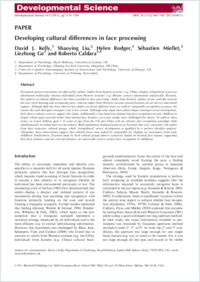Developing Cultural Differences in Face Processing
- Kelly, David J. Department of Psychology, Royal Holloway, University of London, UK
- Liu, Shaoying Department of Psychology, Zhejiang Sci‐Tech University, Hangzhou, PR China
- Rodger, Helen Centre for Cognitive Neuroimaging, Institute of Neuroscience and Psychology, University of Glasgow, UK
- Miellet, Sebastien Centre for Cognitive Neuroimaging, Institute of Neuroscience and Psychology, University of Glasgow, UK
- Ge, Liezhong Department of Psychology, Zhejiang Sci‐Tech University, Hangzhou, PR China
- Caldara, Roberto Centre for Cognitive Neuroimaging, Institute of Neuroscience and Psychology, University of Glasgow, UK / Department of Psychology, University of Fribourg, Switzerland
-
2011
Published in:
- Developmental Science. - 2011, vol. 14, no. 5, p. 1176-1184
English
Perception and eye movements are affected by culture. Adults from Eastern societies (e.g. China) display a disposition to process information holistically, whereas individuals from Western societies (e.g. Britain) process information analytically. Recently, this pattern of cultural differences has been extended to face processing. Adults from Eastern cultures fixate centrally towards the nose when learning and recognizing faces, whereas adults from Western societies spread fixations across the eye and mouth regions. Although light has been shed on how adults can fixate different areas yet achieve comparable recognition accuracy, the reason why such divergent strategies exist is less certain. Although some argue that culture shapes strategies across development, little direct evidence exists to support this claim. Additionally, it has long been claimed that face recognition in early childhood is largely reliant upon external rather than internal face features, yet recent studies have challenged this theory. To address these issues, we tested children aged 7–12 years of age from the UK and China with an old ⁄ new face recognition paradigm while simultaneously recording their eye movements. Both populations displayed patterns of fixations that were consistent with adults from their respective cultural groups, which ‘strengthened’ across development as qualified by a pattern classifier analysis. Altogether, these observations suggest that cultural forces may indeed be responsible for shaping eye movements from early childhood. Furthermore, fixations made by both cultural groups almost exclusively landed on internal face regions, suggesting that these features, and not external features, are universally used to achieve face recognition in childhood.
- Faculty
- Faculté des lettres et des sciences humaines
- Department
- Département de Psychologie
- Language
-
- English
- Classification
- Psychology
- License
-
License undefined
- Identifiers
-
- RERO DOC 27172
- DOI 10.1111/j.1467-7687.2011.01067.x
- Persistent URL
- https://folia.unifr.ch/unifr/documents/301921
Statistics
Document views: 120
File downloads:
- Developing Cultural Differences in Face Processing: 436
